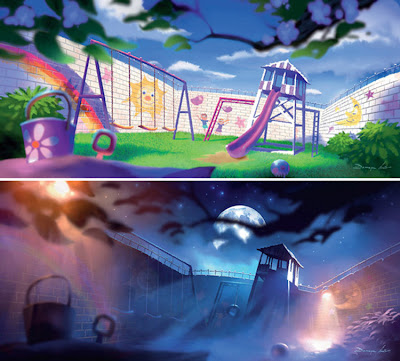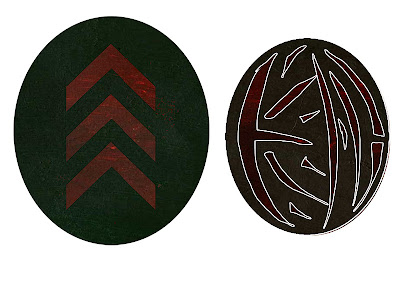In this concept art piece from the incredibles. To me, the colour scheme suggests a very broken atmosphere around the house because of the fact that our heroes now have to adapt to normal human living, thus cutting off their glory that was their superpowers. The colour scheme itself looks very broken and the sight of Mr Incredible outside on his own with the barbecue with his broken colour scheme only further emphasises his and their misery.
This concept from the third installment of Toy Story (Toy Story 3 that is...) shows Woody and Buzz the protagonists in a colour scheme that consists of warming colours. For me looking in on this, the colours in this painting have been carefully considered to show the emotional relationship between the two toys.
These concepts above and below again from Toy Story 3 are for me ironic. The character of Lotso'huggin bear is an irony of an otherwise at this time nice warming atmospheric scene where warm harmonious hues have been put together to create a harmonious environment. He himself is designed to decieve the audience into thinking he is one with the scenery with his welcoming pinky purplish coloured fur. But even looking closely at him in the image below, the colour of his fur looks broken, is it the shadows involved in the scene, or something else? I make this statemen due to the fact that Lotso turns out to be the primary antagonist of the film.
Again from Toy Story 3, this is to most the touching moment in The film when Andy reaches the age of maturity and goes to college, leaving his beloved Woody and Buzz and the remaining toys behind in the hands of a new owner. The colour choice adds a warm and harmonious feel on an otherwise emotional moment.
In this scene from Toy Story 2, the colour scheme used for the discovery of the abandoned toy Wheezy. The use of broken blue colours, some of which overlap onto Wheezy further show the dark nature of abandonment as Wheezy who was shelved after his squeaker was out of action found out.
In this concept from Toy Story 3, this scene shows several of Lotso's associates gathering in a dark area of the Sunnyside daycare centre gossiping in bad light about the newcoming toys (Andy's toys that is...). The broken yellowy greeny brown colours create a dark and evil atmosphere with the yellowy light revealing some of their faces.
These two concepts of the Sunnyside daycare centre in Toy Story 3 show the centre in two different moods according in this case to the time of day. Of course, during the day with the children being dropped off by their parents the colour scheme is designed to look child friendly with bright colours and a warming welcoming atmosphere. However, at night, with Lotso and his minions in control, the day care centre becomes a torture camp, further emphasised by the dark blues and the spotlights with a colour scheme suited to intimidate escapee toys.
This scene relates to Lotso's upbringing by his former owner, who unwillingly abandoned him one night, unwillingly creating the path for his evil ways. Though Lotso wasn't always that way. This concept painting shows him in a good light with his former owner who from her position in this image, cherished him as her toy. Here, the colour scheme in the overall scene is somewhat broken, its warm, but broken in the sense as to not overshadow the subjects of interest, in which case are the two characters.
Pablo Picasso's the tragedy uses a great range of broken blue hues to shed light on a dark situation. The characters are submerged in broken blues to show being frozen to the touch in numbness in response to this tragedy that Picasso is trying to convey here.
I see this quite often in anime wallpapers, often from looking on google and the occasional youtube video where people post up anime wallpapers here and there. This anime wallpaper has been composed in broken colours to mark a bleak situation for this character. She herself has been de-saturated in her colour scheme to fit into the scene while not losing her status of authority as the subject of attention.
This film poster from Tim Burton's Corpse Bride film shown above and below is a film entirely made of a broken colour scheme. However, this approach fitted in well with the film. From looking at Burton's gothic art style, this use of a broken colour palette is welcomed.













